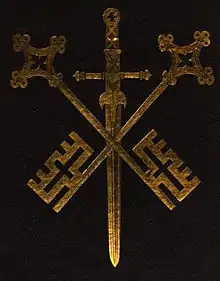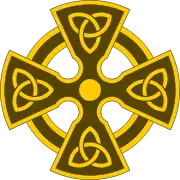Ancient British Church
The Ancient British Church was a British religious movement founded by Jules Ferrette (Mar Julius) and Richard Williams Morgan (Mar Pelagius).[1]

| Part of a series on |
| Celtic Christianity |
|---|
 |
| Portal Christianity |
The Ancient British Church was founded circa 1874 as a restoration of the Christian church of the first millennium in the British Isles.
The leader of the Ancient British Church was styled as "British Patriarch".
Although the name Ancient British Church is no longer used, a number of present-day bodies may be said to have derived (or partly derived) from the Ancient British Church, for example the British Orthodox Church, the Celtic Orthodox Church, the Evangelical Apostolic Church of North America (Syro-Chaldean) (which in 2015 reverted to its pre-1992 name Syro-Chaldean Church of North America), and the Ancient British Church in North America. The Free Protestant Episcopal Church (which in 2012 adopted the name Anglican Free Communion) was merged or very closely linked with the Ancient British Church from 1897 until 1939 and from 1900 to 1939 leadership of these two bodies coincided in the same sequence of individuals.
Foundation
Richard Williams Morgan was given the full title Mar Pelagius I, Hierarch of Caerleon-on-Usk by Ferrette in Oxfordshire in 1858. Mar Julius is said to have conditionally "baptised, confirmed, ordained and consecrated" Pelagius the first Patriarch of the Church.[1]
Morgan and Ferrette planned the movement as an attempt to restore a form of Christianity in Britain that they called Neo-Celtic Christianity.[2] They claimed that it existed in a syncretistic, druidic form prior to the entry of Augustine of Canterbury and the Synod of Whitby. Morgan hoped to establish a "tradition in Britain as part of a world-wide Orthodox Movement which would eventually lead to the reunion of Christendom".[1]
Notable works
The extensive publications of John Williams (Ab Ithel),[1] Iolo Morganwg,[3] Morgan and Ferrette influenced the founding of the movement.[2] Notable works include Saint Paul in Britain and The British Kymry or Britons of Cambria by Morgan and The Ecclesiastical Antiquities of The Cymry or Ancient British Church its History, Doctrine and Rites (cover with a sword and crossed keys pictured) by Ab Ithel.[1][2]
John Pryce, vicar at Bangor, Gwynedd, "refuted all the legends concerning the introduction of Christianity to Britain" in an essay written in 1876,[1](p50)[4] shortly before the death of Pelagius.
Continuation
Early days
The Church continued after Morgan's death, described as having "always remained rather shadowy, rather an idea than a community". It was thought that "the idea, no matter how shadowy was to survive."[1]
Charles Isaac Stevens (Mar Theophilus I), formerly a Reformed Episcopal Church presbyter, succeeded Morgan in 1879.[5] Stevens in turn consecrated Leon Chechemian, an Armenian vardapet, who took the religious name Mar Leon.[2]
Merger (1897)
On 2 November 1897, the Ancient British Church, led by Stevens, merged with the Free Protestant Church of England, founded and led by Chechemian, and the Nazarene Episcopal Church, founded and led by James Martin, to form a new church called the Free Protestant Episcopal Church (full name: Free Protestant Episcopal Church of England). For its first three years, the united church was led by Chechemian, until 30 December 1900 at which point Chechemian handed-over the reins of the Free Protestant Episcopal Church to Stevens.
1900 to 1945
Stevens served until his death on 2 February 1917.
Stevens was succeeded by Martin, who served until his death on 2 February 1919.
Martin was succeeded by Andrew Charles Albert McLagan who served until his death on 16 October 1928.
McLagan was succeeded by Herbert James Monzani-Heard, a former Anglican deacon who lived until 1947.[2] Monzani-Heard had been consecrated Archbishop of Selsey in 1922.
On 18 May 1939, William Hall took over as primus of Free Protetant Episcopal Church, in succession to Monzani-Heard. However Monzani-Heard continued as leader of the Ancient British Church until 29 January 1945, when he was succeeded by Hugh George de Willmott Newman (Mar Georgius).
Catholicate of the West and British Orthodox Church
The Ancient British Church was led by Hugh George de Willmott Newman from 1945 until his death in 1979. For part of this time the name Catholic Apostolic Church (Catholicate of the West) was used. (Note: This should not be confused with the "Irvingite" church called "Catholic Apostolic Church", though de Willmott Newman had grown-up in that church and his thinking was influenced by it).
De Willmott Newman's cousin, William Henry Hugo Newman Norton (Mar Seraphim) took over in 1979, and continues to serve (as at 2014).
The name Orthodox Church of the British Isles was adopted, and later the name British Orthodox Church. Under Newman Norton, it became a canonical local church within the Coptic Orthodox Church of Alexandria in 1994, but relinquished this status in 2015.
Celtic Orthodox Church
Some adherents, who did not support becoming a local church within the Coptic Orthodox Church of Alexandria, considered that Newman Norton had seceded, and they continued as the Celtic Orthodox Church, and regard themselves as the genuine continuing body.
Ancient British Church of North America
Jonathan Vartan Zotique (born Thomas William Brennand on 21 March 1946 in Toronto, Ontario) was consecrated Mar Zitikos and formed the small Ancient British Church in North America (The Autocephalous Glastonbury Rite in Diaspora).
Ancient British Church (Agnostic)
The line of succession also continued at least into the late 1950s in Britain under Dorian A. F. Herbert of Newport, Wales, who was the head of the offshoot Ancient British Church (Agnostic).[6]
Free Protestant Episcopal Church (now re-named Anglican Free Communion)
Succession from Morgan's Ancient British Church is also found in the Free Protestant Episcopal Church (now the Anglican Free Communion).[7] From 1900 until 1939 the Ancient British Church and the Free Protestant Episcopal Church shared the same succession of leaders (Stevens, Martin, McLagan and Monzani-Heard). However, on 18 May 1939 Monzani-Heard appointed William Hall as primus of the Free Protestant Episcopal church, but retained leadership of the Ancient British Church until 29 January 1945 when he handed over the Ancient British Church to Hugh George de Willmott Newman. From 1939 onwards, the Free Protestant Episcopal Church had its own separate succession of leaders (namely William Hall, Charles Dennis Boltwood, Albert John Fuge (Snr), Charles Kennedy Samuel Stewart Moffatt and Edwin Duane Follick).
A splinter group existed between 1978 and 2011 led by Horst Block and Peter Leers.
Syro-Chaldean Church of North America, also known as Evangelical Apostolic Church of North America (Syro-Chaldean)
The Syro-Chaldean Church of North America originated around 1973. In 1992, the Church adopted the name Evangelical Apostolic Church of North America (Syro-Chaldean) but in 2015 reverted to its original name.
Succession from the Ancient British Church, via Charles Dennis Boltwood (primus of the Free Protestant Episcopal Church after William Hall) and John Marion Stanley (Mar Yokhannan) and Bertram Schlossberg (Mar Uzziah Bar Evyon) is to be found in the Syro-Chaldean Church of North America, formerly called the Evangelical Apostolic Church of North America (Syro-Chaldean).[lower-alpha 1]
Pentecostal Churches of Christ and Apostolic Pastoral Congress
In 1995, the Evangelical Apostolic Church of North America (Syro-Chaledean) entered into collegial fellowship with United Pentecostal Churches of Christ (USA) and granted apostolic succession to Archbishop J. Delano Ellis and the UPCofC house of bishops. There is thus a succession from the Ancient British Church to the Pentecostal Churches of Christ (USA), the United Covenant Churches of Christ (USA) (both of these being bodies deriving from the United Pentecostal Churches of Christ) and to the Apostolic Pastoral Congress (another body deriving succession from J. Delano Ellis and UPCofC/PCofC).
List of "British Patriarchs"
The style "British Patriarch" was adopted by the leader of the Ancient British Church.
- First Patriarch: Mar Pelagius I (Richard Williams Morgan) (lived circa 1815-1889) (served as Patriarch 1874-1879)
- Second Patriarch: Mar Theophilus (Charles Isaac Stevens) (lived 1835-1917) (served as Patriarch 1879-1917) (NOTE: On 30 December 1900, Stevens was appointed Primus of the Free Protestant Episcopal Church, and his successors as British Patriarch also carried this role until 1939).
- Third Patriarch: Mar Jacobus I Antipas (James Martin) (served as Patriarch 1917-1919)
- Fourth Patriarch: Mar Andries I (Andrew Charles Albert McLagan) (lived 1851-1928) (served as Patriarch 1919-1928)
- Fifth Patriarch: Mar Jacobus II (Herbert James Monzani-Heard) (lived 1861-1947) (served as Patriarch circa 1930-1945) (NOTE: On 18 May 1945, Monzani-Heard separated the role of British Patriarch from that of Primus of the Free Protestant Episcopal Church in that he appointed William Hall as Primus of FPEC but retained to himself the role of British Patriarch and leader of the Ancient British Church).
- Sixth Patriarch: Mar Georgius I (Hugh George de Willmott Newman) (lived 1905-1979) (served as Patriarch 1945-1979)
- Seventh Patriarch: Mar Seraphim I (William Henry Hugo Newman-Norton) (born 1948) (served as Patriarch from 1979, but did not actively use this style or title from 1994 until January 2019).
From 30 December 1900 until 18 May 1939, the leadership of the Ancient British Church (the "British Patriarch") and the Primacy of the Free Protestant Episcopal Church coincided.
The style "British Patriarch" was not used by Mar Seraphim during the years (1994 to 2015) that the churches of his jurisdiction were canonically part of the Coptic Orthodox Patriarchate of Alexandria (an Oriental Orthodox jurisdiction), but was revived about three years afterwards, in that a Declaration issued December 2018 stated that with effect from 1 January 2019 Mar Seraphim would once again be styled as "British Patriarch".
However, Monseigneur Meal I (Paul-Eduard de Fournier de Brescia) was appointed (circa 1995) to lead the churches that had not acceded to Coptic canonical jurisdiction and Mgr Mael I has been regarded as Eighth Patriarch. These churches adopted the name Celtic Orthodox Church. Monseigneur Mael I died on 20 July 2014 and was succeeded on 5 October 2014 by Monseigneur Marc I (Jean-Claude Scheerens). However, the church is regarded as part of the French church and the style British Patriarch is not used.
In a "Primatial Decree" dated 1 August 2015, the Apostolic Episcopal Church claims that the post of "British Patriarch" was vacant from 1953 until 2015 and that its leader John Kersey (Mar Joannes Edmundus) became "British Patriarch" in 2015.
See also
Notes
References
- Pearson, Joanne (27 June 2007). Wicca and the Christian Heritage: ritual, sex and magic. Taylor & Francis. pp. 166–. ISBN 978-0-415-25413-7. Retrieved 9 November 2012.
- Günther H. Thomann (2001). A Short Biography of the Reverend Richard Williams Morgan (c.: 1815-1889), the Welsh poet and re-founder of the Ancient British Church: An enquiry into the origins of neo-Celtic Christianity, together with a reprint of several works by Richard Williams Morgan and Jules Ferrette, etc. St. Ephrem's Inst. Retrieved 9 November 2012.
- Marion Löffler (2007). The literary and historical legacy of Iolo Morganwg, 1826-1926. University of Wales Press. ISBN 978-0-7083-2113-3. Retrieved 10 November 2012.
- Pryce, John (1878). The ancient British church : a historical essay. London: Longmans, Green. OCLC 680499284.
- "Block". encyclopedia.jrank.org. Archived from the original on 2012-10-13. Retrieved 2012-11-10. This tertiary source reuses information from other sources but does not name them.
- James R. Lewis (2002). The encyclopedia of cults, sects, and new religions. Prometheus Books. ISBN 978-1-57392-888-5. Retrieved 10 November 2012.
- "The Anglican Free Communion: History". The Anglican Free Communion. Archived from the original on 2013-09-24. Retrieved 20 April 2013.